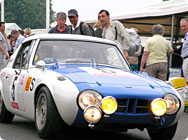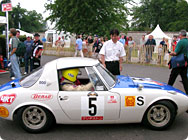Experienced Drivers Talk about “Then” and “Now”
toyota-f1.com Interview |
|
|
 |
Takehiko Kitahara:
A Toyota Ace Driver Reflect back on the 1960s |
|
|
It's Important to Create an Environment for Passing Dreams on to the Next Generation
• So the accumulation of know-how over the years is the reason we have the type of racing we see today…
“Right. Back then we had the Tokyo Olympics and Japan was coming back as an economic power. Younger people started to be interested in riding motorcycles and driving cars. There was a kind of ‘wave’ that swept us along. But again, there weren’t video games and computers for young people to entertain themselves. The ones that spent all of their time on motorcycles or behind the wheel were the ones that eventually became the pros.”
 |
 |
| Kitahara and the S800 return to the paddock after a demonstration drive. Kitahara drove with the headlights on, reflecting the car's setup on an endurance specification. |
|
• There couldn’t have been much in the way of information or technology, though…
“You’ve got that right. You had to make everything yourself. And once I got started, I just couldn’t stop (laughs). That’s where all of my money and time went (laughs).”
• I would think that festivals like this one, and the F1 Japan Grand Prix have helped inspire many youngsters to become professional racers. What is your take on how to build an environment to foster these ambitions?
“I think that Japan is still in the process of creating that type of environment. But I don’t think our culture has progressed to the point where many parents view motor sports as a sport. I don’t think our society is quite there, yet, either. It will take some more time. But if we can get kids out to these events, and get them interested—to be more conscious of motor sports…if there’s a great enough number of these types of people, then we’ll see growth in
the number of drivers, and in the popularity of motorsports. Without that, it will be tough. For example, back then even a champion didn’t rate much notice. When I was driving, there were autograph events, and I was a guest on radio shows quite often, of course, but it’s important for the media to really embrace and promote the sport, too. Even back then there were short gymkhana instructional courses on T.V. under the pretext of ‘Sunday Sports,’ but I think there needs to
be more opportunities for kids to come in contact with motorsports—it needs to become more familiar. And I think those that are already in racing now should do more to create that kind of environment. For example, having a single-pass all-access system when bringing youngsters to the circuit. If there isn’t a general popularity to the sport, then the top people in the sport today won’t have much influence among the kids. Once a good environment has been established, then you’ll
see kids who yearn for motorsports, and dream of becoming drivers. There will be a realistic expectation that they’ll reach their dreams. When that starts to happen, you’ll see people like me doing as much as we can to push it farther.”
|
|
|
The Mind is the Most Valuable Treasure
• Speaking as a former Toyota ace driver, what is your impression of Toyota’s motorsports activities since your days as a driver, up to and including Toyota’s F1 program?
“Japan’s auto manufacturers in the 1960s and ‘70s were fairly isolated from the world. At that time, there were high customs tariffs to prevent cheaper goods from coming into the country, so the Japanese companies competed ruthlessly among themselves, without worrying much about what was happening overseas. At the time, the biggest question was whether passenger cars would sell in Japan. Racing served as a means for public relations—a way to appeal to younger consumers. When
I was first invited to start racing, I felt like I needed to take some time and see what was actually going on. My first race was actually as an ‘observer’ (laughs). The auto manufacturers were really casting their fate to the wind back then.”
• In other words, the reasons behind racing were quite a bit different back then…
“Yes, that’s right. It really wasn’t considered a competitive sport. At first, it was mainly a way to advertise—increase sales. Later, the notion of ‘sport’ came into play. There wasn’t any rule-making organizations or the like. The JAF wasn’t even around until later.”
• I’m sure after 40 years of experience, participating in a festival of this magnitude—driving based on your natural reflexes—must be a very emotional experience…
“Yes, that’s true. I’ve both gained and lost in terms of financial treasures, but I’ve never lost my mental capabilities, and my body still moves pretty good, too. I think that I still have a lot to offer in this field, and I want to do what I can to help.”
 |
 |
| |
Looking directly from the side reveals the compactness of the body. |
• It seems like many of the ‘elder statesmen’ of the sport are very positive and open-minded…
“It might be as you say. I think drivers who have made it to an elite level in the sport have had to be very strong both physically and mentally. They couldn’t make it otherwise. In a competitive world, you don’t win every time, you lose quite often, too. That makes you stronger. In other words, we thrive on that…thrive on the competition, the thrill of the race. It’s a world where you can rely on yourself to think of a way—some way, some how—to overcome the
competition. That’s what makes it meaningful. That’s the only thing that makes it meaningful.”
|
| < back | |
|
|